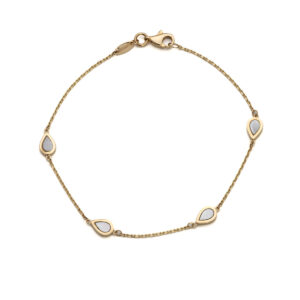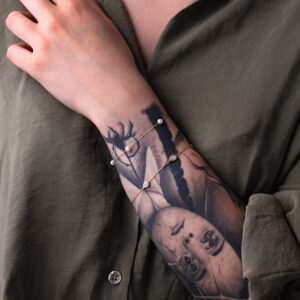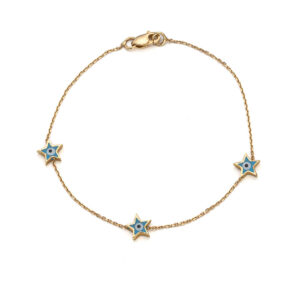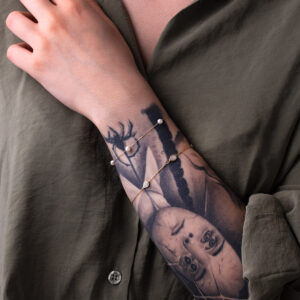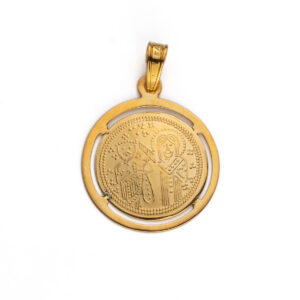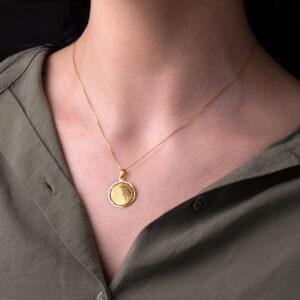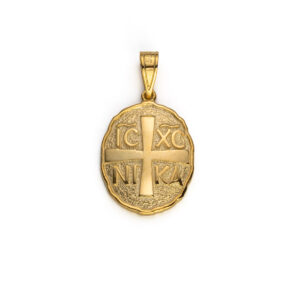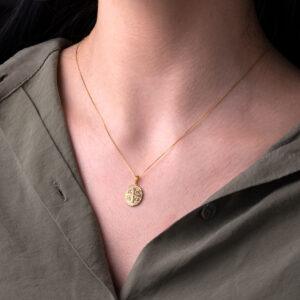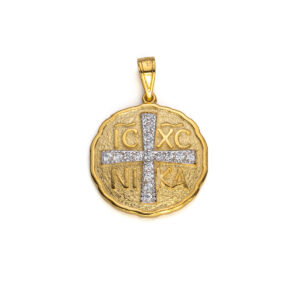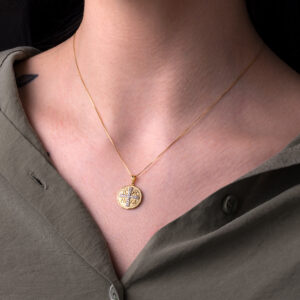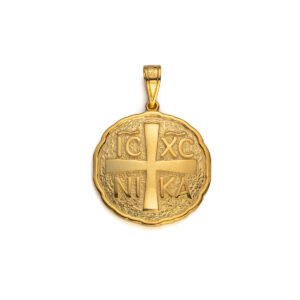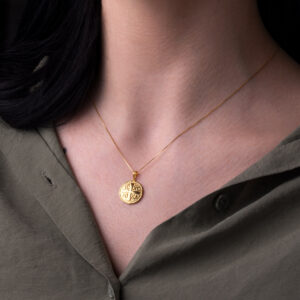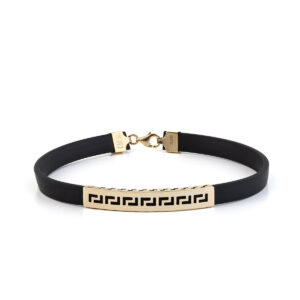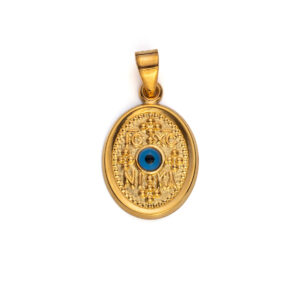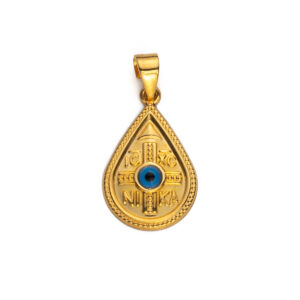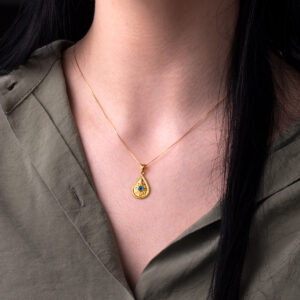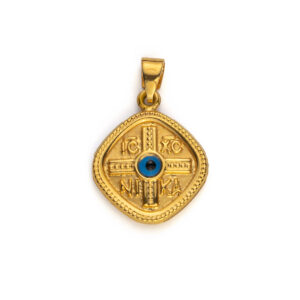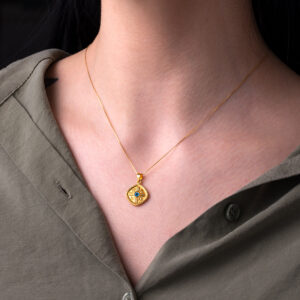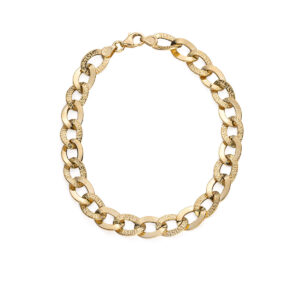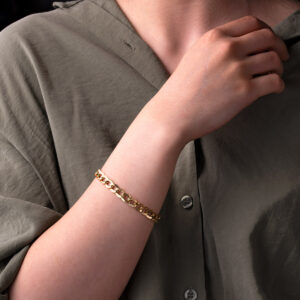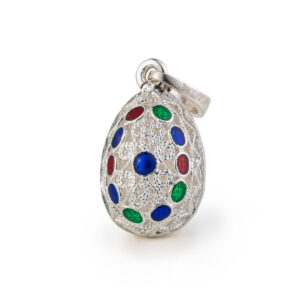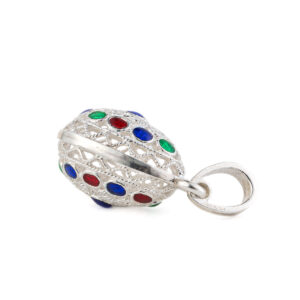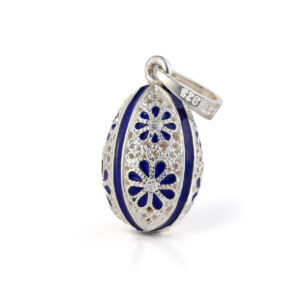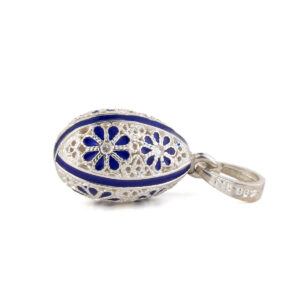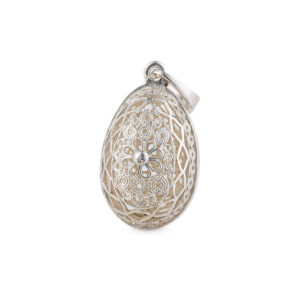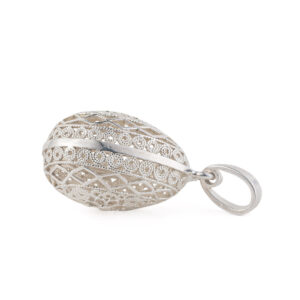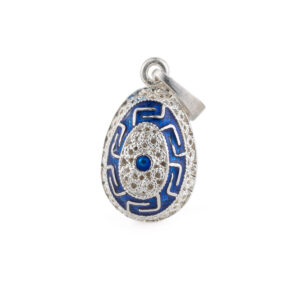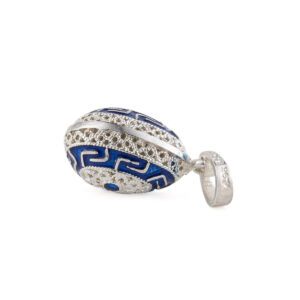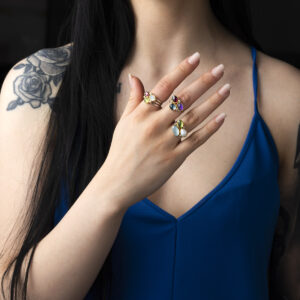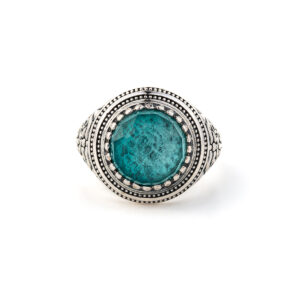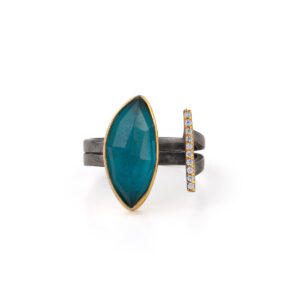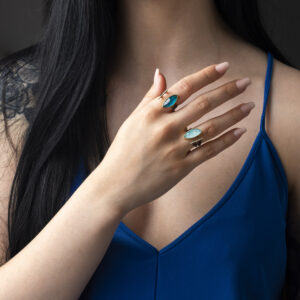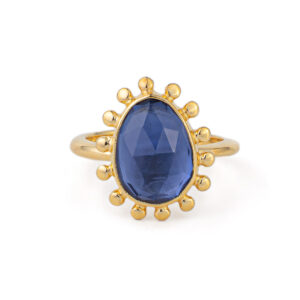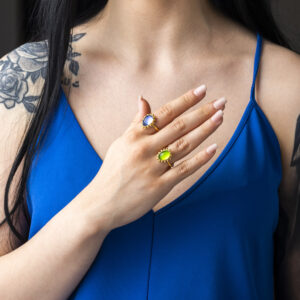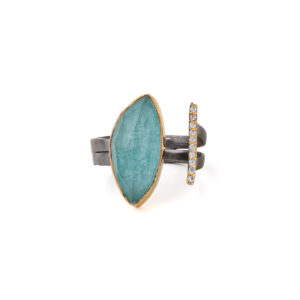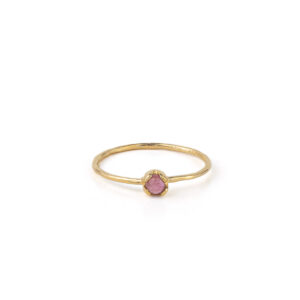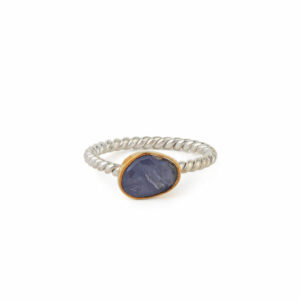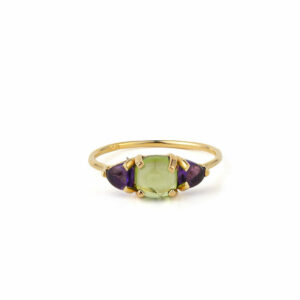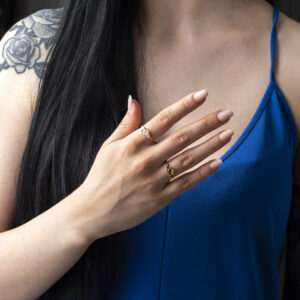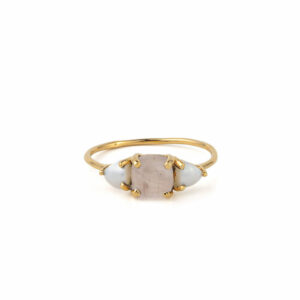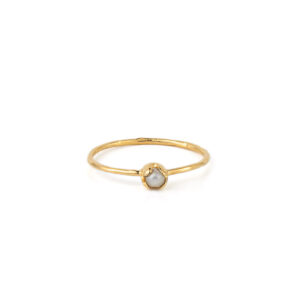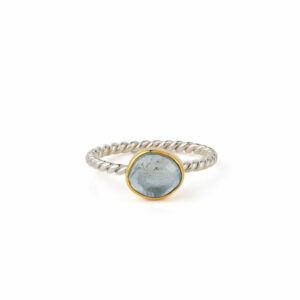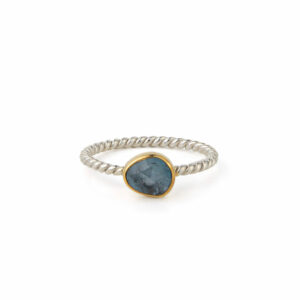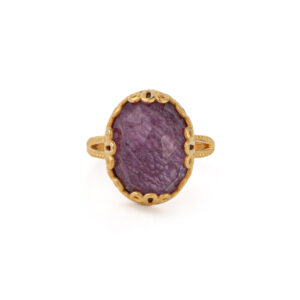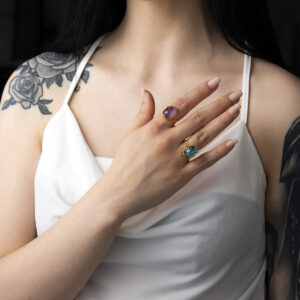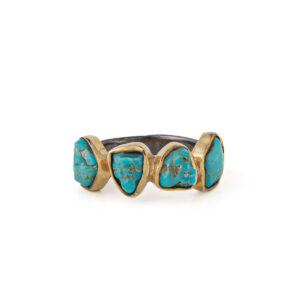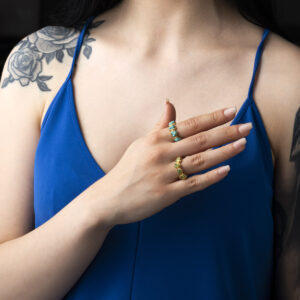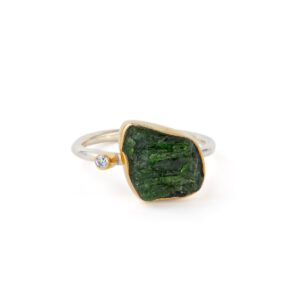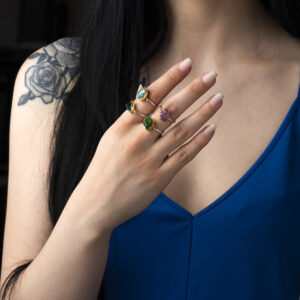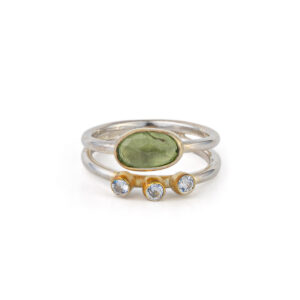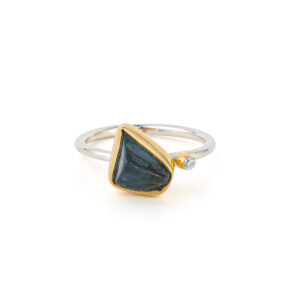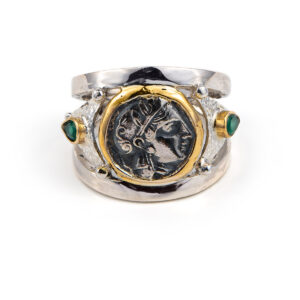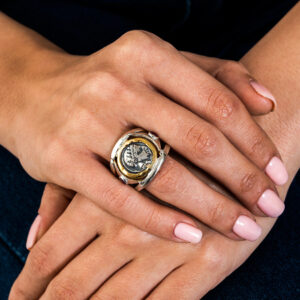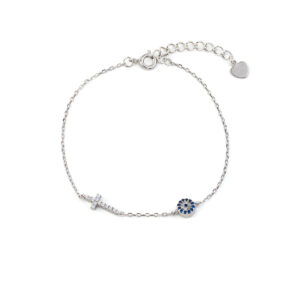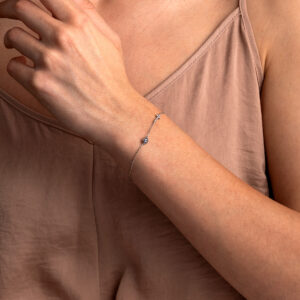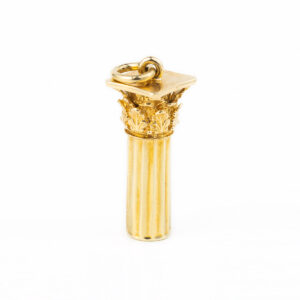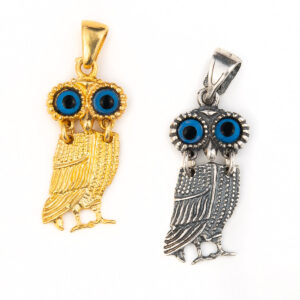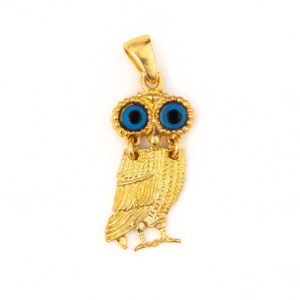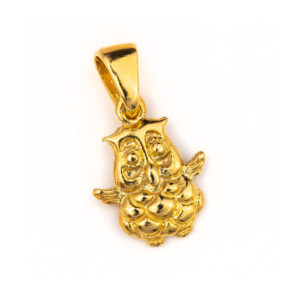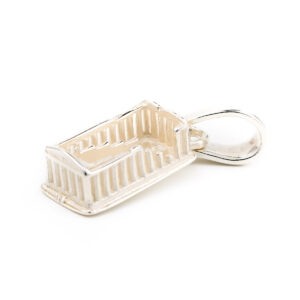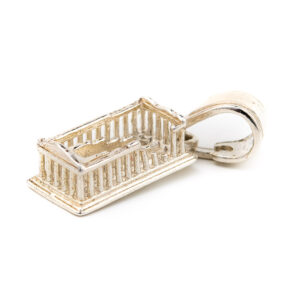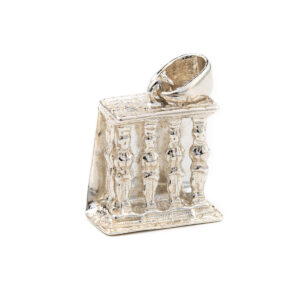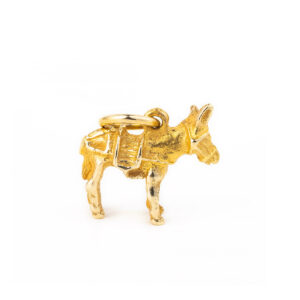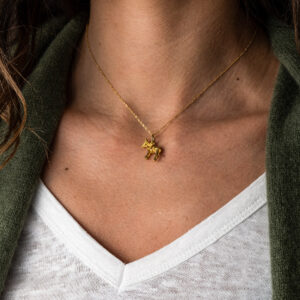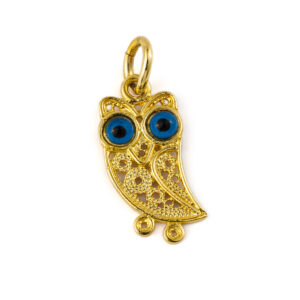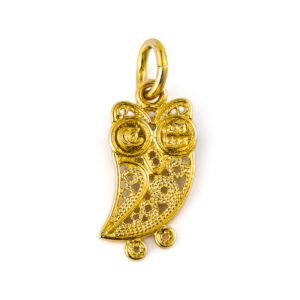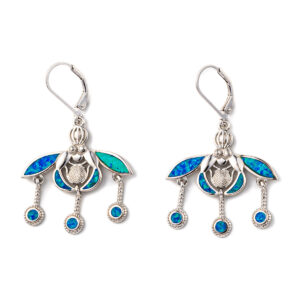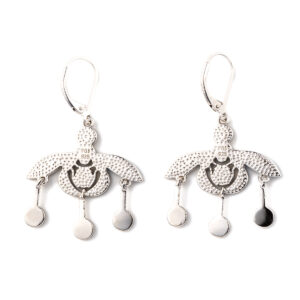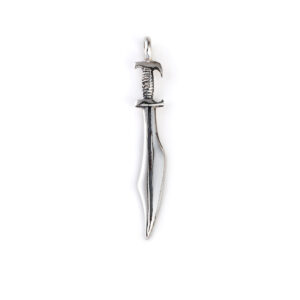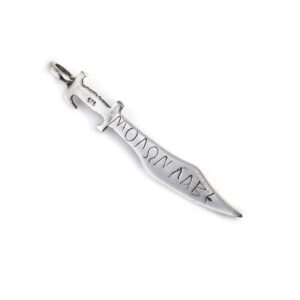Βραχιόλι Μάτι με Αστέρια – 14Κ Χρυσό
365,00€Made of 14K yellow gold
Handmade in Greece
The symbol and superstition of the evil eye is one of the strongest symbolic images in the world. The earliest known evidence for belief in the evil eye goes back to ancient Greece and Rome. It is supposed to wear off evil to anyone who wears it.
Κωνσταντινάτο Μενταγιόν Στρογγυλό – 9Κ Χρυσό
195,00€Κατασκευασμένο από Χρυσό 9Κ.
Χειροποίητο Ελληνικό Κόσμημα.
Κωνσταντινάτο Μενταγιόν Οβάλ – 9Κ Χρυσό
215,00€Κατασκευασμένο από Χρυσό 9Κ.
Χειροποίητο Ελληνικό Κόσμημα.
Μενταγιόν Κωνσταντινάτο με Σταυρό – 9Κ Χρυσό
267,00€ – 357,00€Κατασκευασμένο από Χρυσό 9Κ.
Χειροποίητο Ελληνικό Κόσμημα.
Κωνσταντινάτο Μενταγιόν – 9Κ Χρυσό
232,00€ – 357,00€A handmade gold pendant that depicts Saints Constantine and Helena on the one side and Christogram with the initials IC XC NIKA (Jesus Christ conquers) on the other side.
Is a unique pendant which you can offer to your special ones as a protection gift or buy it for yourself.
Made of 9k gold.
Handmade in Greece
Βραχιόλι με Μαίανδρο – 14Κ Χρυσό
472,00€Κωνσταντινάτο Μενταγιόν Οβάλ με Μάτι – 9Κ Χρυσό
135,00€Κατασκευασμένο από Χρυσό 9Κ.
Χειροποίητο Ελληνικό Κόσμημα.
Κωνσταντινάτο Μενταγιόν Σταγόνα – 9Κ Χρυσό
162,00€Κατασκευασμένο από Χρυσό 9Κ.
Χειροποίητο Ελληνικό Κόσμημα.
Κωνσταντινάτο Μενταγιόν Ρόμβος – 9Κ Χρυσό
198,00€Κατασκευασμένο από Χρυσό 9Κ.
Χειροποίητο Ελληνικό Κόσμημα.
Κολιέ με Μενταγιόν Αυγό – Ασήμι 925
The pendant is embellished with a fine filigree and multicolor enamel in Faberge style.
Made of 925 sterling silver.
Handmade in Greece.
The chain shown is included.
Filigree is a delicate kind of jewellery metalwork, made with tiny beads or twisted threads, or both in combination, soldered together or to the surface of an object of the same metal and arranged in artistic motifs. The art of filigree dates back to ancient history. The first of the found jewelry in this technique have been found in Mesopotamia and dates to thousands of years BC. In the ancient world and particularly in Asia Minor, this art grew were at the highest level.
Fabergé egg is a jeweled egg created by the House of Fabergé, in St. Petersburg, Imperial Russia. Virtually all were manufactured under the supervision of Peter Carl Fabergé between 1885 and 1917,[citation needed] the most famous being the 50 “Imperial” eggs, 43 of which survive, made for the Russian Tsars Alexander III and Nicholas II as Easter gifts for their wives and mothers. The first Fabergé egg was crafted for Tsar Alexander III, who had decided to give his wife, the Empress Maria Feodorovna, an Easter egg in 1885. Peter Carl Fabergé was a Russian jeweller best known for the famous Fabergé eggs made in the style of genuine Easter eggs, using precious metals and gemstones. He’s the founder of the famous jewelry legacy House of Fabergé.
Κολιέ με Μενταγιόν Αυγό – Ασήμι 925
The pendant is embellished with a fine filigree and blue enamel in Faberge style.
Made of 925 sterling silver.
Handmade in Greece.
The chain shown is included.
Filigree is a delicate kind of jewellery metalwork, made with tiny beads or twisted threads, or both in combination, soldered together or to the surface of an object of the same metal and arranged in artistic motifs. The art of filigree dates back to ancient history. The first of the found jewelry in this technique have been found in Mesopotamia and dates to thousands of years BC. In the ancient world and particularly in Asia Minor, this art grew were at the highest level.
Fabergé egg is a jeweled egg created by the House of Fabergé, in St. Petersburg, Imperial Russia. Virtually all were manufactured under the supervision of Peter Carl Fabergé between 1885 and 1917,[citation needed] the most famous being the 50 “Imperial” eggs, 43 of which survive, made for the Russian Tsars Alexander III and Nicholas II as Easter gifts for their wives and mothers. The first Fabergé egg was crafted for Tsar Alexander III, who had decided to give his wife, the Empress Maria Feodorovna, an Easter egg in 1885. Peter Carl Fabergé was a Russian jeweller best known for the famous Fabergé eggs made in the style of genuine Easter eggs, using precious metals and gemstones. He’s the founder of the famous jewelry legacy House of Fabergé.
Κολιέ με Μενταγιόν Αυγό – Ασήμι 925
The pendant is embellished with a fine filigree and enamel in Faberge style.
Made of 925 sterling silver.
Handmade in Greece.
The chain shown is included.
Filigree is a delicate kind of jewellery metalwork, made with tiny beads or twisted threads, or both in combination, soldered together or to the surface of an object of the same metal and arranged in artistic motifs. The art of filigree dates back to ancient history. The first of the found jewelry in this technique have been found in Mesopotamia and dates to thousands of years BC. In the ancient world and particularly in Asia Minor, this art grew were at the highest level.
Fabergé egg is a jeweled egg created by the House of Fabergé, in St. Petersburg, Imperial Russia. Virtually all were manufactured under the supervision of Peter Carl Fabergé between 1885 and 1917,[citation needed] the most famous being the 50 “Imperial” eggs, 43 of which survive, made for the Russian Tsars Alexander III and Nicholas II as Easter gifts for their wives and mothers. The first Fabergé egg was crafted for Tsar Alexander III, who had decided to give his wife, the Empress Maria Feodorovna, an Easter egg in 1885. Peter Carl Fabergé was a Russian jeweller best known for the famous Fabergé eggs made in the style of genuine Easter eggs, using precious metals and gemstones. He’s the founder of the famous jewelry legacy House of Fabergé.
Κολιέ με Μενταγιόν Αυγό – Ασήμι 925
The pendant is embellished with a fine filigree and enamel in Faberge style.
Made of 925 sterling silver.
Handmade in Greece.
The chain shown is included.
Filigree is a delicate kind of jewellery metalwork, made with tiny beads or twisted threads, or both in combination, soldered together or to the surface of an object of the same metal and arranged in artistic motifs. The art of filigree dates back to ancient history. The first of the found jewelry in this technique have been found in Mesopotamia and dates to thousands of years BC. In the ancient world and particularly in Asia Minor, this art grew were at the highest level.
Fabergé egg is a jeweled egg created by the House of Fabergé, in St. Petersburg, Imperial Russia. Virtually all were manufactured under the supervision of Peter Carl Fabergé between 1885 and 1917,[citation needed] the most famous being the 50 “Imperial” eggs, 43 of which survive, made for the Russian Tsars Alexander III and Nicholas II as Easter gifts for their wives and mothers. The first Fabergé egg was crafted for Tsar Alexander III, who had decided to give his wife, the Empress Maria Feodorovna, an Easter egg in 1885. Peter Carl Fabergé was a Russian jeweller best known for the famous Fabergé eggs made in the style of genuine Easter eggs, using precious metals and gemstones. He’s the founder of the famous jewelry legacy House of Fabergé.
Δαχτυλίδι Aqua Marine Pearl Peridot – Ασήμι 925 Επιχρυσωμένο
Κατασκευασμένο από επιχρυσωμένο ασήμι 925⁰.
Χειροποίητο ελληνικό κόσμημα.
Δαχτυλίδι με Μαλαχίτη – Ασήμι 925
Κατασκευασμένο από ασήμι 925.
Χειροποίητο ελληνικό κόσμημα.
Αυτές οι ασημένιες δημιουργίες των κοσμημάτων Yianni, δημιουργήθηκαν από τον Garbis Khacherian, έμπορο αργυροχοΐας από το 1987.
Ανακαλύψτε τη συλλογή Yianni
Δαχτυλίδι Οξειδωμένο με Πάριμπα – Ασήμι 925 Επιχρυσωμένο
Δαχτυλίδι Μπλε Κρύσταλλο – Ασήμι 925 Επιχρυσωμένο
Κατασκευασμένο από επιχρυσωμένο ασήμι 925⁰.
Χειροποίητο ελληνικό κόσμημα.
Δαχτυλίδι London Topaz Amethyst Rhodolite Garnet – Ασήμι 925 Επιχρυσωμένο
Κατασκευασμένο από επιχρυσωμένο ασήμι 925⁰.
Χειροποίητο ελληνικό κόσμημα.
Δαχτυλίδι Οξειδωμένο με Amazonite – Ασήμι 925 Επιχρυσωμένο
Δαχτυλίδι Aqua Marine Garnet Peridot – Ασήμι 925 Επιχρυσωμένο
Κατασκευασμένο από επιχρυσωμένο ασήμι 925⁰.
Χειροποίητο ελληνικό κόσμημα.
Δαχτυλίδι Βεράκι με Tourmaline – Ασήμι 925 Επιχρυσωμένο
Κατασκευασμένο από επιχρυσωμένο ασήμι 925⁰.
Χειροποίητο ελληνικό κόσμημα.
Δαχτυλίδι Κοχύλι με Ροδολίτη – Ασήμι 925 Επιχρυσωμένο
Κατασκευασμένο από επιχρυσωμένο ασήμι 925⁰.
Χειροποίητο ελληνικό κόσμημα.
Δαχτυλίδι με Τανζανίτη – Ασήμι 925 Επιχρυσωμένο
Κατασκευασμένο από επιχρυσωμένο ασήμι 925⁰.
Χειροποίητο ελληνικό κόσμημα.
Δαχτυλίδι Peridot και Amethyst – Ασήμι 925 Επιχρυσωμένο
Κατασκευασμένο από επιχρυσωμένο ασήμι 925⁰.
Χειροποίητο ελληνικό κόσμημα.
Δαχτυλίδι με Rose Quartz και Μαργαριτάρι – Ασήμι 925 Επιχρυσωμένο
Κατασκευασμένο από επιχρυσωμένο ασήμι 925⁰.
Χειροποίητο ελληνικό κόσμημα.
Δαχτυλίδι Βεράκι με Πέρλα – Ασήμι 925 Επιχρυσωμένο
Κατασκευασμένο από επιχρυσωμένο ασήμι 925⁰.
Χειροποίητο ελληνικό κόσμημα.
Δαχτυλίδι με Aqua Marine – Ασήμι 925 Επιχρυσωμένο
Κατασκευασμένο από επιχρυσωμένο ασήμι 925⁰.
Χειροποίητο ελληνικό κόσμημα.
Δαχτυλίδι με London Topaz – Ασήμι 925 Επιχρυσωμένο
Κατασκευασμένο από επιχρυσωμένο ασήμι 925⁰.
Χειροποίητο ελληνικό κόσμημα.
Δαχτυλίδι Οβάλ με Ruby – Ασήμι 925 Επιχρυσωμένο
Κατασκευασμένο από επιχρυσωμένο ασήμι 925⁰.
Χειροποίητο ελληνικό κόσμημα.
Δαχτυλίδι με Πέτρες Turquoise – Ασήμι 925 Επιχρυσωμένο
Κατασκευασμένο από επιχρυσωμένο ασήμι 925⁰.
Χειροποίητο ελληνικό κόσμημα.
Δαχτυλίδι Diopside – Ασήμι 925 Επιχρυσωμένο
Κατασκευασμένο από επιχρυσωμένο ασήμι 925⁰.
Χειροποίητο ελληνικό κόσμημα.
Δαχτυλίδι με Περίδοτο και Zircon – Ασήμι 925 Επιχρυσωμένο
Κατασκευασμένο από επιχρυσωμένο ασήμι 925⁰.
Χειροποίητο ελληνικό κόσμημα.
Δαχτυλίδι Μπλε Τοπάζι και Ζιργκόν – Ασήμι 925 Επιχρυσωμένο
Κατασκευασμένο από επιχρυσωμένο ασήμι 925⁰.
Χειροποίητο ελληνικό κόσμημα.
Goddess Athena Coin Ring with Emeralds – 14K Gold and 925 Sterling Silver
596,00€Α beautiful ring with Goddess Athena decorated with emeralds.
Made in 14K gold and 925⁰ sterling silver.
Goddess Athena – Athenian silver tetradrachm
Dracma was the currency used in Greece during several periods in its history.
The tetradrachm was an Ancient Greek silver coin equivalent to fourdrachmae in Athens it replaced the earlier “heraldic” type of didrachms and it was in wide circulation from ca. 510 to ca. 38 BC.
The front side of this coin is decorated with Goddess Athena. Athena is an ancient Greek goddess associated with wisdom, handicraft, and warfare.
Athena was regarded as the patron and protectress of various cities across Greece, particularly the city of Athens, from which she most likely received her name. She’s usually shown in art wearing a helmet and holding a spear. Her major symbols include owls, olive trees, and snakes. Her temples were located atop the fortified Acropolis in the central part of the city. The Parthenon on the Athenian Acropolis is dedicated to her, along with numerous other temples and monuments. Her main festival in Athens was the Panathenaia, which was celebrated in midsummer and was the most important festival on the Athenian calendar.
In the classical Olympian pantheon, Athena was regarded as the favorite daughter of Zeus.
Βραχιόλι με Ματάκι και Σταυρό – Ασήμι 925
Bracelet with evil eye and cross, decorated with zircon.
Made in 925⁰ sterling silver.
Evil Eye The symbol and superstition of the evil eye is one of the strongest symbolic images in the world. The earliest known evidence for belief in the evil eye goes back to ancient Greece and Rome. It is suppose to wear off evil to anyone who wears it and various cultures believe in that, however in Greece it’s blue because at that time blue eyes were not so common and were thought to give the evil eye, so the blue is like a mirror to them. Nowadays it’s widely known and has became a trend.
Parthenon Acropolis – 14K Gold Pendant
258,00€Yellow gold charm depicts the monument of the Parthenon the main monument in Acropolis. Built in honor of the goddess Athena, and is the brightest monument of the Athenian state
Made in 14k yellow gold.
Used as a charm on a bracelet or as a pendant on a chain.
The chain shown is our 14K Gold Chain in Length 40cm (not included).
14K Gold Ancient Greek Corinthian Column
728,00€The Corinthian order is named for the Greek city of Corinth, to which it was connected in the period. There are three distinct orders in Ancient Greek architecture: Doric, Ionic, and Corinthian. The Corinthian order is the last developed of the three principal classical orders of ancient Greek and Roman architecture. The Corinthian, with its offshoot the Composite, is the most ornate of the orders. This architectural style is characterized by slender fluted columns and elaborate capitals decorated with acanthus leaves and scrolls. Also there are many variations. The Corinthian Order in 334 BC it appeared as an external feature on the Choragic Monument of Lysicrates in Athens, and then used on a huge scale at the Temple of Zeus Olympia in Athens, (174 BC – AD 132). (Wikipedia)
Used as a charm on a bracelet or as a pendant on a chain.
Made in 14k gold.
Handmade item.
Wisdom Owl Pendant
In Greek mythology, Glaucus is a Little Owl (Athene noctua) that traditionally represents or accompanies Athena, the virgin goddess of wisdom. The bird, often referred to as the “owl of Athena” was allegedly seen as symbol of wisdom and vigilance for its ability to see in the dark and keeping itself awake at night.
This pendant is inspired by the Ancient Greek jewels which represent the symbol of the Wisdom Owl!
Made in house in 925⁰ sterling silver and gold plated.
Handmade item.
Wisdom Owl Pendant
This pendant is inspired by the Ancient Greek jewels which represent the symbol of the Wisdom Owl!
In Greek mythology, Glaucus is a Little Owl (Athene noctua) that traditionally represents or accompanies Athena, the virgin goddess of wisdom. The bird, often referred to as the “owl of Athena” was allegedly seen as symbol of wisdom and vigilance for its ability to see in the dark and keeping itself awake at night.
Available in sterling silver and gold plated.
Handmade item.
Parthenon Charm Sterling Silver Pendant
Silver charm depicts the monument of the Parthenon, the main monument in Acropolis. Built in honor of the goddess Athena, and is the brightest monument of the Athenian.
Used as a charm on a bracelet or as a pendant on a chain.
Available in 3 sizes.
Available in gold 14 kt.
Karyatides Pendant
Karyatides are sculpted female figures serving as an architectural support taking the place of a column or a pillar supporting an entablature on her head.
Used as a charm or as a pendant.
Made in 925⁰ sterling silver.
Handmade item.
14k Gold Donkey Charm
728,00€Γούρι γαϊδουράκι χρυσού 14 καρατίων.
Μέχρι τη δεύτερη χιλιετία π.Χ., ο γάιδαρος μεταφέρθηκε στην Ευρώπη, πιθανώς ταυτόχρονα με την εισαγωγή της αμπελουργίας, καθώς ο γάιδαρος συνδέεται με τον Σύριο θεό του κρασιού, τον Διόνυσο. Χρησιμοποιείται ως γούρι σε βραχιόλι ή ως μενταγιόν σε αλυσίδα. Χειροποίητο αντικείμενο.
Η αλυσίδα που εμφανίζεται είναι η αλυσίδα μας από χρυσό 14 καρατίων σε μήκος 40 cm (δεν περιλαμβάνεται).
14k Gold Filigree Wisdom Owl Pendant
257,00€Wisdom Owl Pendant embellished with a fine filigree.
Made in 14k gold.
Minoan Malia Bees Earrings – 925 Sterling Silver with Opal
Made of 925⁰ sterling silver with blue opal.
The Minoan Bees Pendant, one of the most famous Minoan artworks, was discovered in the Old Palace cemetery at Chrysolakkos, outside the palace of Malia, the third largest and most significant known Minoan palace after Knossos and Phaistos. Chryssolakkos means the “Pit of gold” because of the many precious objects that were found there. The famous pendant dates back to the Bronze Age, (1800 BC) and it’s an stunning, very detailed representation of two bees or wasps storing away a drop of honey to their honeycomb. This pendant is one of the most famous exhibits in the wonderfully Heraklion archeological museum.
Spartan Sword Pendant – Sterling Silver
Leonidas sword pendant.
Handmade pendant.
Made of 925⁰ sterling silver.
On the reverse side is the inscription “μολών λαβέ” which means “come to get”. This phrase was the answer to Xerxes when he asked him to hand over the arms of the defending Greeks to the Thermopylae. Leonidas was a warrior king of the Greek city-state of Sparta. Arguably, one of the greatest heroes in the history of ancient Greece. In 480 B.C Leonidas led an army of 6,000 to 7,000 Greeks from many city-states, including 300 Spartans, who fought the invading Persian army at the pass of Thermopylae. Leonidas of Sparta blocked the only road through which the massive army of Xerxes could pass. The Persians succeeded in defeating the Greeks but sustained heavy losses. A local resident named Ephialtes led the Persian general by a mountain track to the rear of the Greeks. King Leonidas sent away all the Greek troops and stayed behind with 300 Spartans, 400 Thebans, and 700 Thespian volunteers who refused to leave. They were all killed on the battlefield, protecting their homeland.
